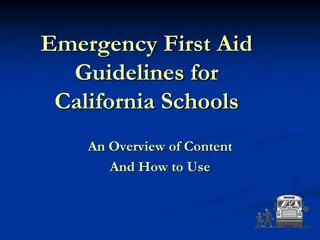High-Rise, Mid-Rise, and Low-Rise Emergency Mitigation Guidelines
High-rise, mid-rise, and low-rise structures pose unique challenges in firefighting due to difficulties in access, inadequate resources, construction complexities, and large number of occupants. This document provides guidelines for responding to incidents in such structures, focusing on safety, rescue priorities, incident control, and property conservation. Strategies for rescue efforts and tactical assignments are also highlighted to ensure effective emergency mitigation in these challenging environments.
Download Presentation

Please find below an Image/Link to download the presentation.
The content on the website is provided AS IS for your information and personal use only. It may not be sold, licensed, or shared on other websites without obtaining consent from the author. Download presentation by click this link. If you encounter any issues during the download, it is possible that the publisher has removed the file from their server.
E N D
Presentation Transcript
HIGH HIGH- -RISE/MID RISE/MID- -RISE/LOW STRUCTURE STRUCTURE EMERGENCY MITIGATION EMERGENCY MITIGATION August 2024 Training RISE/LOW- -RISE RISE
PURPOSE AND OBJECTIVES High-rise fires present unique problems in firefighting. Most of these are related to the difficulties of access, inadequate resources, complexities of construction, and the number of occupants in these structures. Hence, any incident involving a high-rise structure is considered extremely challenging and high-risk. Local jurisdictions may have numerous large mid-rise and low-rise structures that do not meet the height restrictions of a high-rise building but present many of the same extreme challenges. This document is intended to implement guidelines for operations in high-rise, mid- rise, and low-rise fire incidents and address the complex issues related to mitigating those incidents.
INCIDENT PRIORITIES The priorities of rescue in a high-rise, mid-rise, or low-rise structure should be clear to all personnel on the scene, especially to Command. Regardless of the type of alarm received, all personnel responding to these structures will adhere to the following incident priorities: 1. Provide for the safety of firefighters. Establish rapid intervention. 2. Rescue. Protect life using one of three basic rescue strategies: a. Fight the fire and evacuate the occupants, b. Evacuate the occupants only, or c. Shelter the occupants in place and fight the fire. 3. Control the incident. Perform an aggressive attack. 4. Conserve property. Salvage
In high-rise residential structures or commercial high-rise buildings, you must prioritize aerial apparatus in positions of the known location of victims and where close access to the structure can be achieved. For areas above the reach of aerial apparatus, the IC must coordinate the use of a controlled stairway or have occupants shelter in place. Stairways with roof hatches or scuttles are generally used for smoke removal, with positive pressure at the base of the stairs. Stairways without roof openings generally will be used for rescue and evacuation. Note: The rescue or evacuation stairway must also be pressurized with multiple fans at the base of the stairs.
Rescue efforts should be extended in the following order: 1. The most severely threatened victims a. Victim(s) whose location is known or when there is an obvious rescue b. Victim(s) close to the fire (fire floor) c. Victim(s) above the fire (floor above) 2. The largest number (groups) 3. The remainder of the incident area 4. The exposed area
TACTICAL ASSIGNMENTS To achieve the Incident Command Strategic Operating Plan, the first-arriving companies at the scene of a fire must create the foundation that supports the successful mitigation of the event. This includes establishing command, initial scene assessment (size-up), information gathering, and the assignment of initial duties and responsibilities. Initiation of such procedures in the first minutes of the response is critical.
1. Establish command. Regardless of the alarm type or pre- arrival information, command will always be established. It is mandatory that any fire department member responding to high-rise incidents follow the NIMS Incident Command System guidelines. (Refer to Policy 300 in Lexipol) The first-arriving unit will establish command by: Determining the unit designation and the name of command Making a brief radio report that includes a scene size-up and the location of the alpha side





















